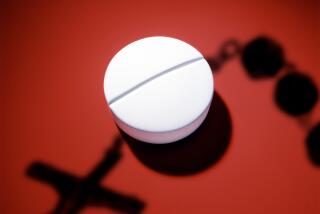RU-486: THE ABORTION BATTLE’S NEW FRONTIER : RU-486: A Chronology
- Share via
1970: Dr. Etienne-Emile Baulieu and his research team discover receptors within uterine cells that interact with the hormone progesterone. They recognize this knowledge might lead to new methods of fertility control.
1980: The Baulieu research team at Roussel-Uclaf, a Paris-based drug company, creates an “anti-hormone” that blocks the progesterone necessary to sustain pregnancy. The steroid is named RU-38486: RU for Roussel-Uclaf and 38486, the number assigned by the firm. It is shortened to RU-486.
1982: Roussel-Uclaf begins clinical tests on women. The drug (used without a prostaglandin booster) averages an effectiveness rate of 80% to 85%. Abortions that fail with the pill are surgically completed.
1983: In the United States, the FDA issues a testing permit on RU-486 to the nonprofit Population Council.
1984: Studies of RU-486 obtained through the Population Council begin in July at L.A. County-USC Medical Center under the direction of Dr. Daniel Mishell. In Sweden, in a study sponsored by the World Health Organization, the effectiveness of RU-486 used in conjunction with a prostaglandin is examined for the first time. In women receiving both RU-486 and a prostaglandin, the abortion effectiveness rate is 94%.
1988: In September, following Roussel-Uclaf trials in which RU-486 produces a success rate of 96%, RU-486 is approved for use in France. In October, Roussel-Uclaf announces it will suspend marketing of RU-486. Two days later, the French minister of health orders RU-486 back on the market. In December, Roussel-Uclaf announces it will suspend distribution of RU-486 outside of France.
1989: In February, Roussel-Uclaf begins widespread distribution of RU-486 to licensed medical clinics and hospitals in France. Women must agree to surgery if a failed abortion results. In September, Baulieu receives America’s prestigious Lasker Award. By October, one year from Roussel-Uclaf’s brief suspension of the drug in France, more than 30,000 women are reported to have used RU-486.
1990: County-USC studies end in mid-February. Efforts to secure more RU-486 are unsuccessful. In March, Roussel-Uclaf announces it is considering marketing RU-486 in Britain, the Netherlands and Scandinavian countries. In March, the New England Journal of Medicine reports on Roussel-Uclaf research concluding that RU-486, coupled with a prostaglandin, is 96% effective--and as safe as suction abortion. In March, the two Democratic candidates for governor of California announce they favor continued United States testing of RU-486.






